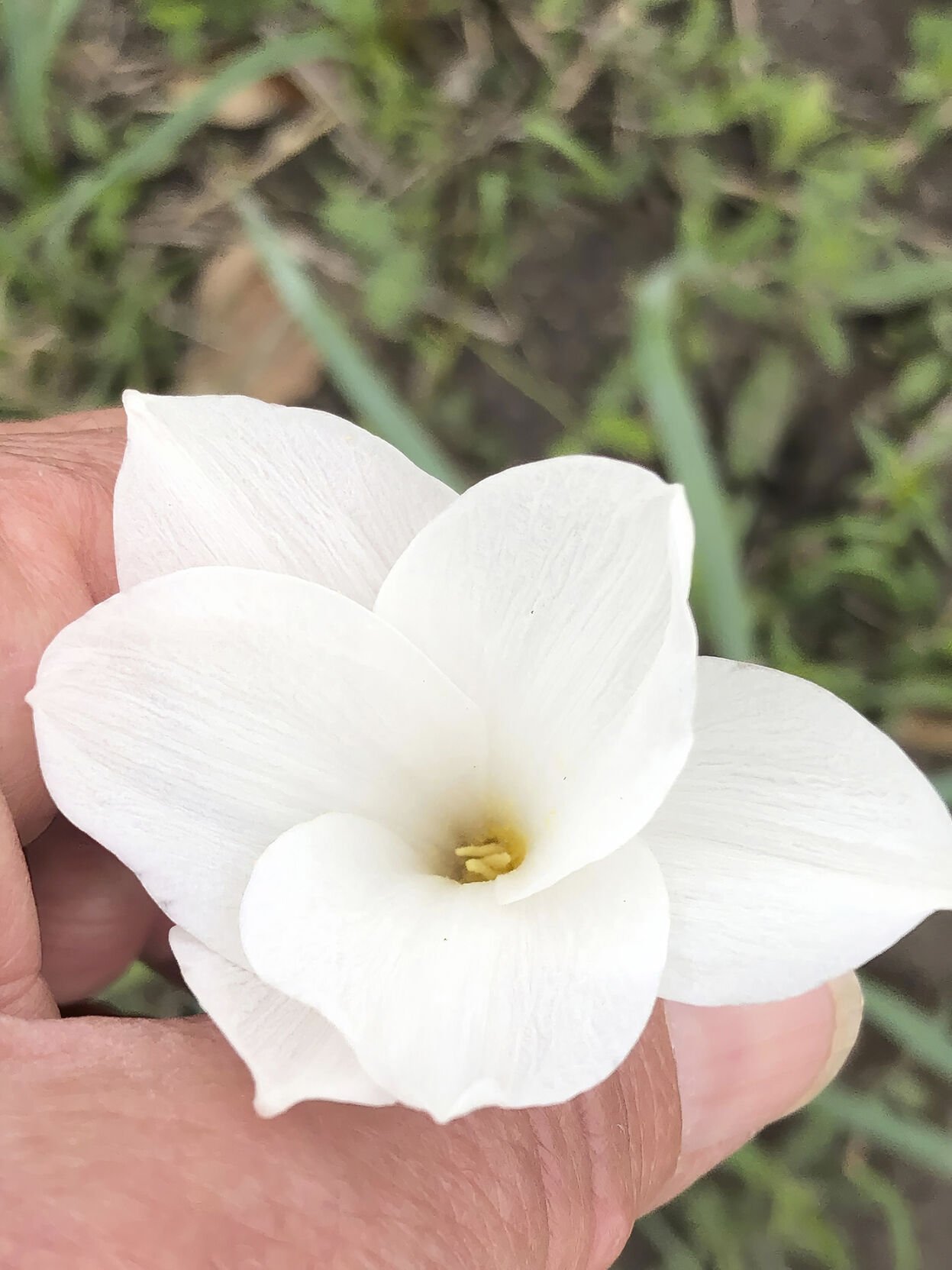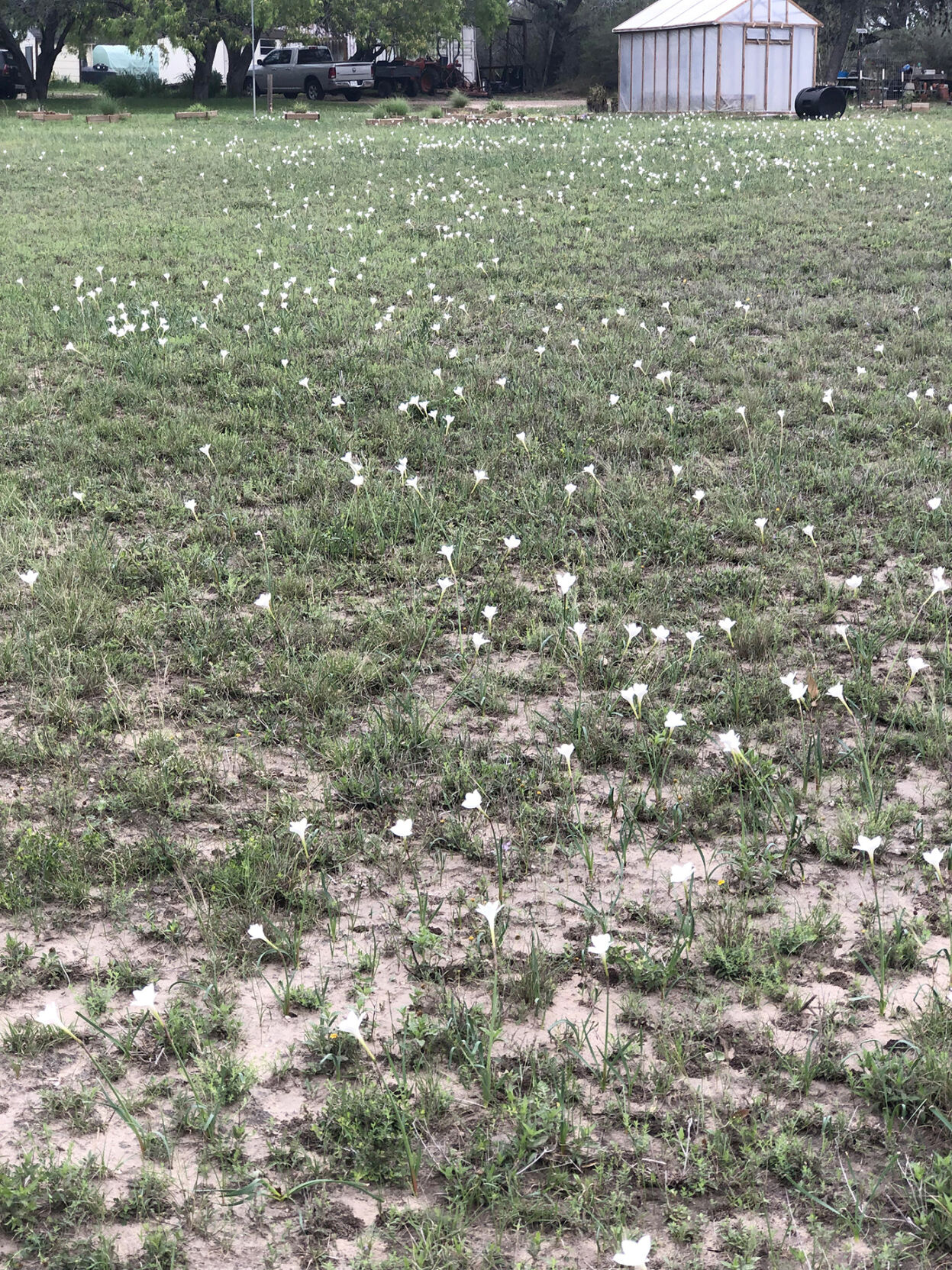The rains that we received last week soaked the ground several inches down. This spurred the bulbs resting down there into action. Within a couple of days, rain lily flower spikes were popping up everywhere.
You have probably seen them along the roadsides, in parks and on many lawns. The white blossoms are set on the tops of slender, straight, green stalks. All the stalks are about the same height, around 12 inches, and there can be a dozen or more on a square foot of lawn. Densely packed together like this, they resemble the candles on a birthday cake!
Rain lilies open in the evening and are at their best the following morning. Within two to four days, the flowers wither and turn pink. The show is over, at least until the next good rain wets the soil again.
The rain lilies blooming now are Prairie Rain Lilies (Cooperia pedunculata). They typically bloom from March to May. The blossoms are up to two and a half inches wide with an equally long tube. At the base of the tube is a green three-sided bulge. This bulge is the flower’s ovary. Below the ovary is an inch-long stalk called the peduncle. The presence of this peduncle is the source of the species’ name, pedunculata.
Prairie Rain Lilies really stand out when they are in bloom. There can be thousands of them blooming at one time. Not too long ago, when the Prairie Rain Lilies were in a spectacular flush of flowers, my friend Kay Past was driving along Viggo Road. Both sides of the road were lined with these bright white rain lilies. She said, “It looked as if the road had been decorated for a wedding!”
Another rain lily, the Evening Star Rain Lily (Cooperia drummondii), blooms later in the summer. It is a bit smaller and more delicate than the Prairie Rain Lily, and it lacks the peduncle below the ovary.
South Texas used to have far less brush and more open prairie. This was when the buffalo roamed, and fire wasn’t suppressed. I can imagine Native Americans encountering stretches of prairie covered in rain lilies. It must have been awe-inspiring.
Early naturalists exploring Texas must have been in a state of plant heaven. One such person, Thomas Drummond, spent two years collecting birds and plants along the Brazos, Colorado and Guadalupe Rivers. This was in the early 1830s. He collected and described so many new species that several have been named in his honor. You’ve probably heard of Drummond’s phlox, a lovely spring wildflower. And, of course, the Evening Star Rain Lily mentioned above has C. drummondii as its scientific name.
Many of these early naturalists suffered hardship and disease, but their strong wills enabled them to persevere. Thomas Drummond was scheduled to join botanist David Douglas (of the Royal Horticultural Society) in an exploration of the far northern parts of the early United States. But he fell ill and was forced to go south instead. That is how he wound up in Texas. Upon arrival in 1831 at the port of Velasco, Drummond contracted cholera. Surprisingly, he recovered enough to do two years of fieldwork in the wilds of Texas. In that time, he collected 750 species of plants! He also prepared 150 specimens of birds. These collections were the first to be made in Texas and were sent to museums and scientific institutions worldwide.
Drummond collected rain lily bulbs while he was in Texas. These he sent to the Botanic Garden in Glasgow, Scotland. From there, they were distributed among plant lovers throughout England and Scotland. One gardener, Joseph Cooper, was among the first to grow rain lilies in Great Britain. Cooper was in charge of the gardens at Wentworth House, Yorkshire, home of the Earl Fitzwilliam. A bulb that Cooper had grown was used in the description and naming of the genus, Cooperia.
Another rain lily bulb was sent to a doctor in Edinburgh, Scotland. When this bulb flowered, it was noticeably different from the ones grown at Wentworth House. Botanists examining it determined that it was similar to the other Cooperia rain lily, but of a different species. It was named Cooperia pedunculata, the Prairie Rain Lily, in 1836.
So much history is wrapped up in these humble little rain lilies. Please think of this when you see them in bloom along our roadsides here in South Texas. Enjoy their beauty and their history!






